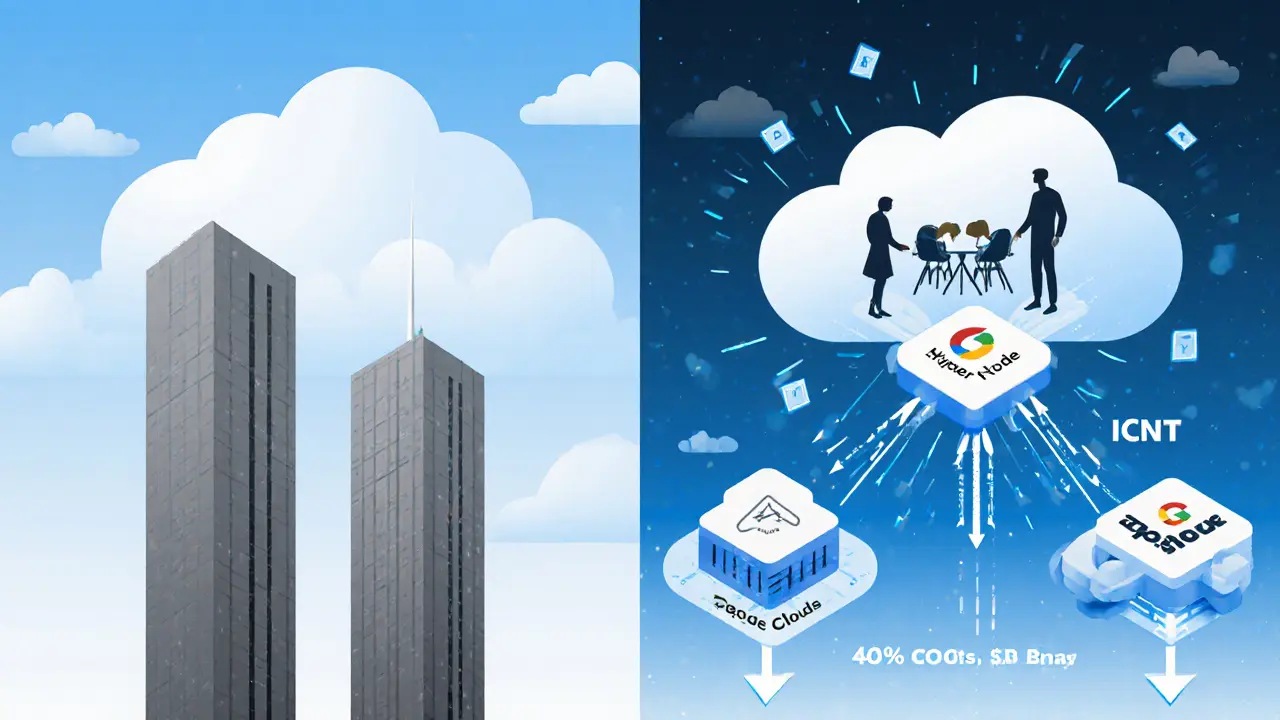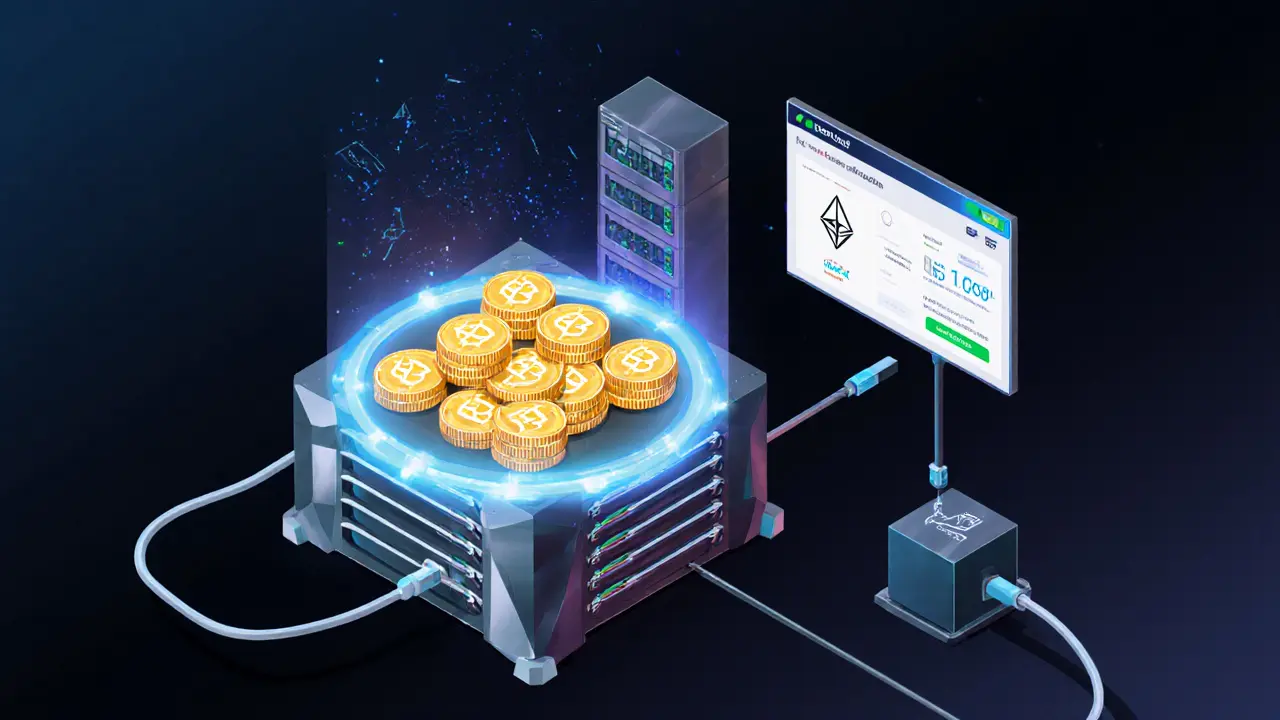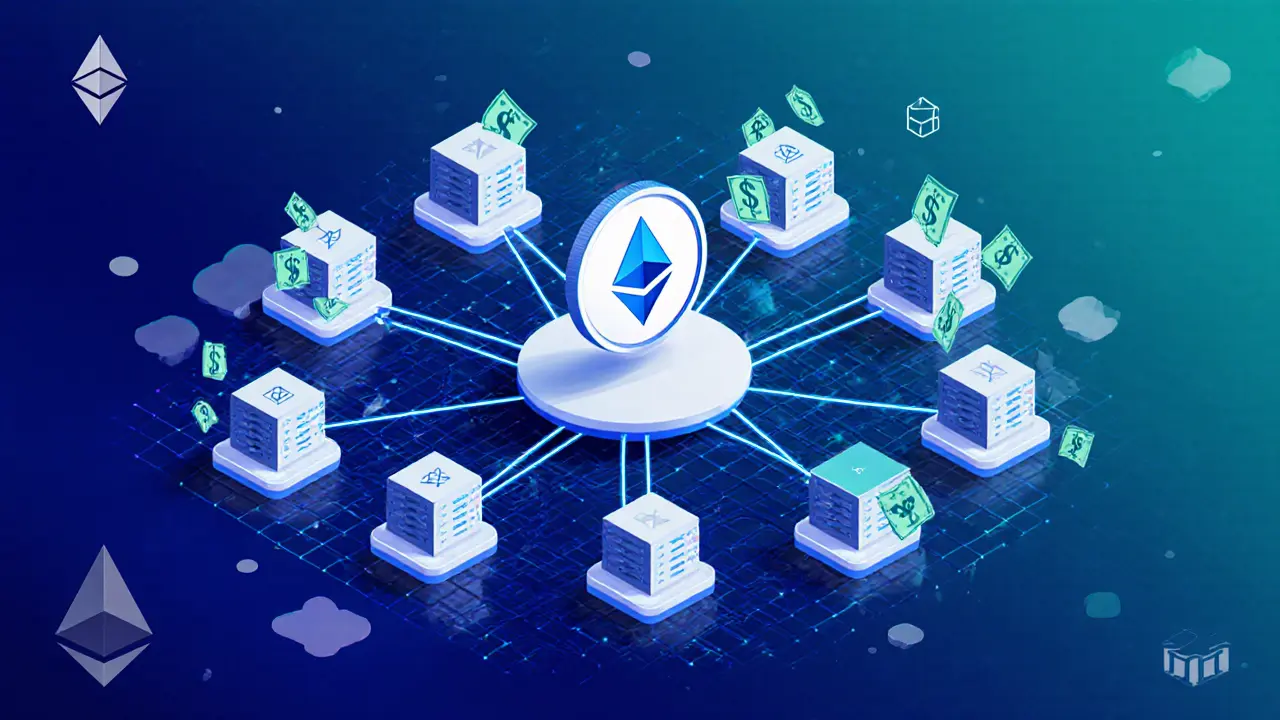Cloud Cost Comparison Calculator
Compare ICNT's cloud services to traditional providers. ICNT offers up to 40% cost savings for cloud resources like compute, storage, and bandwidth.
Based on the article: ICNT users report 30-40% cost savings compared to AWS or Google Cloud for equivalent services.
Enter values above to see your potential savings with ICNT.
The Impossible Cloud Network (ICNT) isn’t just another crypto coin. It’s a bet on rethinking how the internet’s backbone works - and it’s already being used by companies to cut cloud costs by up to 40%. If you’ve ever paid for AWS or Google Cloud and thought, "There’s got to be a better way," ICNT might be the answer you didn’t know you were looking for.
What Exactly Is ICNT?
ICNT is the native token of the Impossible Cloud Network (ICN), a decentralized cloud infrastructure platform. Think of it like AWS or Google Cloud, but instead of being run by one company in a few data centers, it’s powered by thousands of individual servers around the world - all connected through blockchain. Users pay for computing power, storage, and networking using traditional money (USD or EUR), but the underlying network runs on ICNT tokens.
Unlike most crypto projects that focus on trading or speculation, ICNT has a clear, practical job: it’s the fuel that keeps the network running. Hardware operators stake ICNT to join as nodes. Cloud providers use ICNT to access those resources. And when customers pay in dollars, the platform buys back ICNT from the open market to reward node operators. That creates a direct link between real-world usage and token demand.
How Does the Impossible Cloud Network Work?
The system has two types of nodes: HyperNodes and ScalerNodes. HyperNodes are like quality control inspectors - they monitor the network and make sure ScalerNodes are doing their job. ScalerNodes are the ones actually providing compute power and storage. To run a HyperNode, you need enterprise-grade hardware: 32GB RAM, a 1Gbps internet connection, and SSD storage. You also need to stake at least 50,000 ICNT tokens. That’s not cheap, but it’s designed to keep the network secure and reliable.
All transactions happen on Base, Ethereum’s Layer 2 network. This keeps fees low and speeds high. Ethereum itself acts as the final settlement layer - meaning the network’s core rules and ownership are anchored to one of the most secure blockchains in the world.
The whole setup is built for businesses. Gaming companies, AI startups, and Web3 developers use ICN to run their applications without relying on Amazon or Microsoft. And because they pay in fiat, not crypto, it’s easy for traditional companies to adopt without needing to understand wallets or exchanges.
ICNT Tokenomics: Supply, Circulation, and Value
There are 700 million ICNT tokens in total. As of October 31, 2025, about 167.22 million are in circulation - that’s just under 24% of the total supply. The rest are locked up for future node rewards, team allocations, and ecosystem growth.
The token trades at around $0.2935, giving ICNT a market cap of $52 million. Daily trading volume is over $53 million, which is unusually high for a project of this size - suggesting active trading and strong interest.
There’s no official token burn mechanism. Some sites call ICNT "deflationary," but that’s misleading. The token isn’t destroyed. Instead, the network uses a buyback model: as more customers pay in USD/EUR, the protocol uses part of that revenue to buy ICNT from the open market and distribute it to node operators. That increases demand without altering the total supply.

How ICNT Compares to Other Decentralized Cloud Projects
There are other decentralized cloud networks out there - but none do exactly what ICNT does.
- Filecoin (FIL) only does storage. If you need to run a server, you’re out of luck.
- Render Network (RNDR) specializes in GPU rendering for 3D graphics and AI. Great for artists, not for general cloud hosting.
- Akash Network (AKT) offers compute, but it’s harder to use and doesn’t accept fiat payments.
ICNT is the only one that combines compute, storage, and networking into a single platform - and the only one that lets you pay in dollars. That’s a big deal for businesses that don’t want to touch crypto directly.
On market cap, ICNT is smaller than Render ($1.8B) or Filecoin ($2.1B). But its growth rate is accelerating. In Q3 2025, active users grew 18.7% quarter-over-quarter - just below the sector average, but moving in the right direction.
Who’s Using ICNT Right Now?
Real users are already on the network. Gaming startup PixelForge cut their cloud costs by 40% after switching from AWS. A machine learning team in Berlin runs training jobs on ICN because it’s cheaper and more flexible than traditional providers.
But adoption isn’t uniform. The platform has around 1,200 enterprise customers - mostly in gaming (42%), AI/ML (33%), and decentralized apps (25%). Individual users? Less than 5%. This isn’t a coin for retail traders. It’s for teams building tech products who need scalable, affordable infrastructure.
Node operators are mostly data centers and tech firms, not hobbyists. The minimum 50,000 ICNT stake (worth about $14,675 at current prices) keeps out casual participants - and that’s intentional. The network needs serious hardware, not a Raspberry Pi.
Pros and Cons: Is ICNT Worth It?
Pros:
- 30-40% cheaper than AWS or Google Cloud for equivalent services
- Pays in USD/EUR - no need to hold crypto to use it
- Integrated compute + storage + networking in one system
- Backed by top investors: Protocol Labs, 1kx, HV Capital, NGP Capital
- Active roadmap: AI modules, Ethereum upgrades, scaling to 10,000 nodes by 2026
Cons:
- Only 72,070 token holders - small community compared to Filecoin’s 1.2 million
- Documentation is patchy. New users report 3-7 days just to get started
- Node operators have lost staked tokens due to downtime and poor support
- Token price dropped 17.4% in the week before October 31, 2025 - high volatility
- Regulatory risk: accepting fiat payments could attract scrutiny from financial regulators
It’s not for everyone. If you’re a developer who just wants to spin up a server, stick with AWS. But if you’re building something big, want to avoid vendor lock-in, and care about long-term cost savings - ICNT deserves a look.

Can You Buy ICNT? Where and How?
Yes. ICNT trades on major exchanges like MEXC, Gate.io, and Bitrue. You can buy it with USDT, ETH, or BTC. It’s an ERC-20 token on Ethereum, but most trading happens on Base for lower fees.
Don’t buy ICNT because you think it’ll double tomorrow. That’s speculation. Buy it if you believe in decentralized infrastructure and want to support a project that’s already delivering real services. The token’s value is tied to actual usage - not hype.
For node operators, staking ICNT is the real play. But that requires technical skill, reliable hardware, and capital. Most people won’t qualify - and that’s okay. The network doesn’t need millions of small holders. It needs hundreds of serious operators.
What’s Next for Impossible Cloud Network?
The roadmap is ambitious. In Q4 2025, they’re launching AI-specific compute modules - optimized for training large language models. In Q2 2026, they’ll integrate with Ethereum’s Proto-Danksharding upgrade, which will massively reduce data costs on Layer 2.
They aim to hit 10,000 nodes by the end of 2026. That’s up from around 1,500 today. If they succeed, ICNT could capture 3-5% of the decentralized cloud market - worth billions.
But it’s not guaranteed. Competitors are watching. Big cloud providers like Oracle and Microsoft are experimenting with their own decentralized models. If they roll out cheaper, easier alternatives, ICNT could be squeezed.
The biggest threat isn’t technology. It’s adoption. Right now, ICNT is a niche tool for tech-savvy teams. To scale, they need better docs, faster support, and more case studies. If they fix those, the network could become the backbone for the next generation of web apps.
Final Thoughts: Is ICNT a Coin or a Tool?
ICNT isn’t a currency you hold to get rich. It’s a utility token - a key to a new kind of cloud. Its value comes from how much the network is used, not how many people are buying it.
If you’re a developer, startup founder, or tech investor, ICNT is worth tracking. It’s one of the few crypto projects that’s already solving a real business problem - and doing it with real customers paying real money.
It’s not perfect. The community is small. The learning curve is steep. The price swings. But if decentralized cloud infrastructure is the future - and there’s strong evidence it is - then ICNT is one of the few tokens that’s already building it.
Is Impossible Cloud Network (ICNT) a good investment?
ICNT isn’t a speculative investment like many meme coins. Its value is tied to real-world usage. If businesses keep adopting the network and paying in fiat, demand for ICNT will grow. But if adoption stalls, the price could fall. Only invest what you can afford to lose, and only if you understand the technology behind it.
Can I stake ICNT to earn rewards?
Yes - but only if you operate a HyperNode. You need 50,000 ICNT, enterprise-grade hardware, and technical skills. Rewards come from the network’s buyback program, not staking interest. Retail users can’t stake ICNT on exchanges to earn passive income.
How is ICNT different from AWS or Google Cloud?
AWS and Google Cloud are centralized - owned by one company. ICNT is decentralized, powered by thousands of independent servers. You pay less (30-40% cheaper), avoid vendor lock-in, and support open infrastructure. But setup is more complex, and support isn’t as fast as enterprise cloud providers.
Why does ICNT trade on Base instead of Ethereum?
Ethereum is too slow and expensive for daily transactions. Base, a Layer 2 network built on Ethereum, offers faster, cheaper transactions while still being secured by Ethereum’s main chain. ICNT is an ERC-20 token, but most trading and transfers happen on Base for efficiency.
Is Impossible Cloud Network safe to use?
The network’s code is open-source and audited. Its security relies on blockchain consensus and staking requirements. But like any tech platform, user errors can cause losses - like failing to keep a node online, which can result in lost staked tokens. Always follow official documentation and use strong security practices.

Eli PINEDA
November 1, 2025 AT 17:59icnt? more like impossible to understand lol. why do they make it so hard to just spin up a server? i just want to run my ai model, not become a sysadmin.
Genevieve Rachal
November 1, 2025 AT 22:14Let’s be real - this is just another crypto shell game dressed up as infrastructure. 50k ICNT stake? That’s a $15k entry fee to play with toys the big boys already own. And don’t get me started on the ‘buyback’ myth - it’s not deflationary, it’s just a liquidity pump with a fancy name. The only thing being decentralized is the delusion.
Malinda Black
November 3, 2025 AT 02:52Hey, I get why this feels overwhelming - I was right there. But if you’re a dev or startup founder tired of AWS price hikes, give ICNT a real shot. I helped a friend set it up last month. Took 5 days, yeah, but now their monthly bill’s half what it was. The docs are rough, but the community’s actually helpful if you ask nicely. It’s not magic - but it’s real.
Chris Strife
November 3, 2025 AT 11:44Decentralized cloud? In America? Please. This is just another foreign-funded tech fantasy. We have AWS, Azure, Google - why would any sane person risk their business on some blockchain hodgepodge built by guys in basements? This isn’t innovation. It’s ideological noise.
Mehak Sharma
November 5, 2025 AT 05:56ICNT is not just a token - it’s a movement. Imagine a world where your startup doesn’t get throttled by corporate cloud monopolies. Where compute power is as open as the internet itself. Yes, the setup is clunky. Yes, the price swings. But look at the adoption curve - gaming studios, AI labs, Web3 builders - they’re all switching. This isn’t speculation. This is the quiet revolution. And you’re either building it or being replaced by someone who is.
Debby Ananda
November 5, 2025 AT 22:34Okay but like… $0.29? 😏 That’s practically free money if you believe in the vision. I mean, if this hits $5, we’re all retired. And if it doesn’t? Eh, I lost less than my coffee budget. 🤷♀️✨
Ron Cassel
November 6, 2025 AT 00:53They say it’s on Base. But Base is owned by Coinbase. And Coinbase is owned by the same Wall Street pigs who run the traditional system. You think you’re decentralized? You’re just moving from one cage to another with a blockchain tattoo. This is a trap. The whole thing is a front for crypto laundering. Wake up.
Phil Higgins
November 6, 2025 AT 14:34There’s something poetic about this - a decentralized cloud, powered not by greed, but by utility. We’ve spent decades building empires on centralized control, and now we’re seeing the cracks. ICNT doesn’t promise to make you rich. It promises to make infrastructure fair. That’s not a coin. It’s a covenant. And maybe, just maybe, that’s worth more than any price chart.
Vicki Fletcher
November 7, 2025 AT 15:50Wait - so you pay in USD, but the network runs on ICNT… so if the token crashes, do the nodes just… shut off? And who’s liable if your AI training job dies because someone’s node went offline? This feels like renting a car from a guy who only shows up when he feels like it. And the docs? They’re written by someone who thinks ‘understandable’ means ‘in another language’.
Jason Coe
November 7, 2025 AT 17:10I’ve been running a HyperNode for 6 months now. Yeah, the 50k ICNT stake hurt - but the rewards? Consistent. We’ve had maybe 3 minor downtimes, and support responded in under 8 hours each time. The real win? My company saved $18k last quarter on cloud costs. I know people say it’s risky - but the math checks out. If you’re serious about infrastructure, this isn’t a gamble. It’s a strategic upgrade.
David Roberts
November 9, 2025 AT 12:58ICNT’s tokenomics are structurally unsound. The buyback mechanism creates artificial demand without reducing supply - it’s a classic pump-and-dump facade disguised as utility. And the node operator attrition rate? Over 12% in Q3. That’s not reliability - that’s systemic fragility. The only thing more unstable than the price is the narrative.
Monty Tran
November 9, 2025 AT 18:30Everyone’s acting like this is the future. But let’s be honest - if this was real, Amazon would’ve bought it by now. Or at least copied it. The fact that they haven’t means one thing: it’s not scalable. It’s a niche toy for crypto bros who hate corporations but still need them to pay their bills.
Beth Devine
November 10, 2025 AT 20:45I know it sounds crazy, but I tried ICNT for a small ML project last month. Took longer than expected - but it worked. And it was cheaper. I didn’t need to learn crypto wallets. I just paid with a card. That’s huge. If you’re on the fence - try it with $50 of compute. See if it works for you. No pressure. Just test it.
ISAH Isah
November 12, 2025 AT 10:28Why must you Americans always assume your infrastructure is superior? In Nigeria we have decentralized power grids powered by solar and blockchain. ICNT is not revolutionary. It is merely a western rebranding of a concept already implemented in emerging economies. The real innovation is not in the code - it is in the arrogance of claiming ownership over a global idea.
Brian McElfresh
November 14, 2025 AT 03:07They say it’s audited. But who audited the audit? And why is the team anonymous? And why did the lead dev disappear after the token launch? And why does the website use a .io domain registered through a shell company in the Caymans? This isn’t decentralized - it’s a ghost network with a PR team.
Hanna Kruizinga
November 14, 2025 AT 03:46ICNT? More like ICNT-Impossible to get support. My node went down for 14 days. No response. Lost 8k ICNT. And now they’re pushing ‘AI modules’ like it’s a magic fix. If you’re not a tech billionaire with a dev team, don’t touch this. It’s a graveyard for hopefuls.
Wesley Grimm
November 15, 2025 AT 09:06Market cap $52M? Daily volume $53M? That’s pure speculation. The ratio is 1:1 - meaning every dollar in value is being traded, not held. This isn’t adoption. It’s casino behavior wrapped in enterprise jargon. The real users? They’re not buying tokens. They’re using the service. And their numbers are still tiny.
David James
November 16, 2025 AT 21:46Look I’m not a crypto guy but my buddy runs a gaming studio and they switched to ICNT. He said it’s way cheaper and they don’t get locked in. I didn’t understand half of it but he’s happy. So maybe it’s not all hype. Just take it slow. Don’t bet your rent on it.
Nadiya Edwards
November 18, 2025 AT 20:40They say it’s backed by Protocol Labs and NGP Capital. But who are those people? Are they connected to the same people who ran the 2008 housing crash? Are they using this to funnel money out of the system? This isn’t innovation - it’s financial camouflage. And they’re selling it to people who don’t know any better.